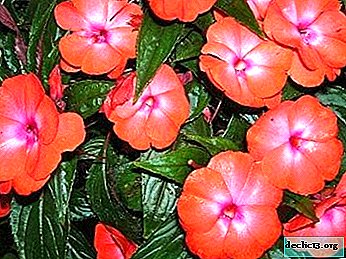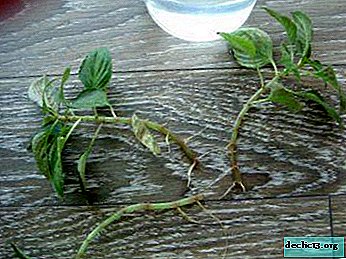Indoor Balsam: growing and caring at home. Pests and diseases

Another name for balsam is Roly wet. It is no coincidence that they call him that in common people. He loves moisture. If he does not get it, all the leaves sag and wilt. Sometimes "Vanka’s tears" appear on them.
Drops of moisture are observed on the leaves only on sunny days, when the evaporation is strong. Is it difficult to grow and care for balsam at home?
In this article we will tell you what kind of flower it is, what are the features of caring for it and what problems and pests they encounter when growing balsam.
What kind of flower is this?
Balsamine is a plant that belongs to the Balsamic family. There are many species (400), and they are conditionally subdivided into single and perennial ones. It grows in sub- and tropical climates, in the states of Asia and Africa.
Reference! Translated from Latin, the word "balsam" is translated as "impatient." The fruits of the plant are special. If you touch them accidentally, they will crack, throwing the seeds over a long distance.The plant has bushy, juicy and soft stems. All leaves are whole or serrated. They are lanceolate. Stipules missing. The arrangement of leaves on the stem is opposite or whorled. Their color is green, but the shade is different. During flowering, irregularly shaped flowers appear.
They are either terry or simple. More often the arrangement is solitary, less often they are collected in loose inflorescences. Flowers can be red, white or yellow. After flowering, the fruit is formed - a multi-seeded box.
Features and conditions of breeding
No matter how different types of balsam differ from each other - by the structure of the stem, the shape of leaves and flowers, but they have common characteristic features:
 The need for moisture. If you dry the soil in a pot, forgetting about timely watering, the plant disappears. The only thing that does not tolerate "wet Roly" is the stagnation of moisture in the roots.
The need for moisture. If you dry the soil in a pot, forgetting about timely watering, the plant disappears. The only thing that does not tolerate "wet Roly" is the stagnation of moisture in the roots.- Planting in a small pot to improve flowering. When planting a large volume in a flowerpot, balsam will spend all its energy on tillering and growth. It will not bloom, and it is insulting for every grower.
- Easy propagation by seeds or cuttings. You can grow a new plant from the mother in the shortest possible time.
- Diseases leading to loss of decorative effect.
After buying, balsam must be transplanted. Soil is carefully selected for him, stopping his choice on a light substrate, specially selected for a flowering plant. Without listening to this advice, gardeners are faced with the appearance of an abundance of leaves on the stems, but with an almost complete absence of flowers. Do not plant a flower in heavy soil rich in nitrogen compounds and minerals. It is better to feed the crop twice a month.
Two balsam stalks with flowers of different colors are planted in one flowerpot. Due to its rapid filling with roots, it is transplanted twice a year - in spring and autumn. You can read about the intricacies of planting and care in this article.
Breeding methods
There are two ways to propagate balsam: seed and cuttings. What is the best way for beginners to choose?
Cuttings are an easy way to propagate perennial balsam. It is not laborious, and if desired, even a layman will cope with the task. The main thing is that healthy shoots fall into the new pot. They are cut carefully, counting the two internodes when cutting.
After the cut, shoots are placed in water or immediately planted in moist soil. Very soon, the new balsam will take root. If you kept the shoots in water, you can transplant it after the roots appear in a 10-centimeter pot. After a few months, under normal conditions, the balsam will bloom: when planted in the fall, flowers will appear in the spring.
Important! You can not transplant the annual balsam: it dies immediately after flowering.When grafting balsam, you will need a mother plant, a capacity for rooting and perlite. In addition, a pruner is useful to cut the shoots.
 A cut of shoots 50-70 mm long. It is not made over a sheet, but under it.
A cut of shoots 50-70 mm long. It is not made over a sheet, but under it.- Removing lower leaves and buds.
- Taking the capacity for rooting, put perlite in it. It is advisable to seal it carefully, and only after that make a small indentation with a stick at a depth of 15-20 mm. A stalk is inserted into it, ramming the ground.
- Before rooting, remove the container in a warm, bright place. To make the process go faster, they feed the plant with complex fertilizer before trimming.
The seed method of propagation of balsam is also chosen because of the simplicity and feasibility of execution on any day of the year. Sometimes you don’t even have to do something, as self-seeding takes place. As already stated above, seed boxes burst during any careless movement near them. This becomes a serious reason for self-seeding.
Many flower growers start balsam, do not care for it, as a result of which it turns into a weed. Experienced flower lovers try to dress the seed boxes with a clear, lightweight fabric to prevent them from scattering. Harvested seeds will remain viable for eight years.
The risk of seed propagation - obtaining a plant that does not meet expectations. When self-collecting seeds from balsam growing on the windowsill, they are not surprised after reproduction by the absence of new maternal traits.
Read about breeding at home and subsequent transplantation into the open ground here.
Next, a visual video about the propagation of balsam by cuttings:
How to grow at home?
Balsam is a non-capricious plant. Some species grow in the shade, others in the sun. It needs abundant watering in the spring and summer, when the weather is hot outside. In winter, it will not die if you provide a room temperature in the region of 15 ° C.
With the onset of spring, room balsam is fertilized so that it blooms. To do this, watered it with special fertilizers for flowering plants every two weeks.
Attention! Any overgrown plant can be rejuvenated without transplantation, if you just cut off the unlikely stems. They can be put in water, and after the appearance of the roots, planted in pots.Read about how to care for balsam at home so that the plant will please you with its appearance for a long time.
Plant problems
Balsam, like any other indoor plant, can get sick.
Pests
- Spider mite.
Sign: yellow specks on the surface of the leaves. If untreated, they increase in size, the leaves lose their green color and dry. To stop the insect, they struggle with dry air and high temperature in the room.
The best way to combat the spider mite is to spray the plant with water. If you notice a pest on one leaf, it is better to cut it off, and treat everything that is nearby with mineral oil or a soap solution.
 Whitefly.
Whitefly.Symptom: an abundance of yellow leaves with specific sticky secretions on the inner or outer surfaces. To combat use special tools that are sold in a flower shop: Tanrek, Spark, Actellik.
- Multi-claw ticks.
Signs: hardening and curvature of leaves. Their growth stops. Over time, they curl around the edges. To defeat the disease, prevent high humidity and high temperature in the room. A great way is to thoroughly examine the plant and treat the leaves with Acarin, Lightning, Fitoverm, etc.
- Thrips.
Symptoms: deformation of young leaves, spots on the flowers and browning of the petals along the edges. When the first signs appear, flowers and leaves affected by thrips are removed. This pest is fond of young plants, and therefore, immediately after transplantation or purchase they are monitored. An effective way to get rid of it is to buy drugs Actara, Spark, Fufanon, etc.
Disease
- Leaf fall due to hypothermia, irregular watering and lack of light. Having solved the problem with lighting, balsam will please with an abundance of flowers on the stems.
- Leaf curl. This problem is caused by the activity of a spider web or multi-claw tick. All affected parts are removed, and the whole plant is treated with a special solution.
- Yellowing leaves. Most often, the problem is caused by a spider mite or lack of moisture. As soon as the grower normalizes watering and processes the leaves, it disappears.
- Bud drop due to overdrying or waterlogging of soil masses.
- Leaf drying due to lack of moisture.
- Stretching stems due to increased room temperature and lack of sunlight.
- Flowering problem due to lack of light and nutrients. By rearranging the pot to another place and fertilizing twice a month, they will solve it. You will learn how to water balsam and how to feed it for abundant flowering here.
Read more about balsam diseases here.
Useful video
Further, a visual and informative video about indoor balsam:
Conclusion
Balsam is an unpretentious plant. He will delight you with white or red flowers several times a year, if you create good conditions for growth.

 The need for moisture. If you dry the soil in a pot, forgetting about timely watering, the plant disappears. The only thing that does not tolerate "wet Roly" is the stagnation of moisture in the roots.
The need for moisture. If you dry the soil in a pot, forgetting about timely watering, the plant disappears. The only thing that does not tolerate "wet Roly" is the stagnation of moisture in the roots. A cut of shoots 50-70 mm long. It is not made over a sheet, but under it.
A cut of shoots 50-70 mm long. It is not made over a sheet, but under it. Whitefly.
Whitefly.















